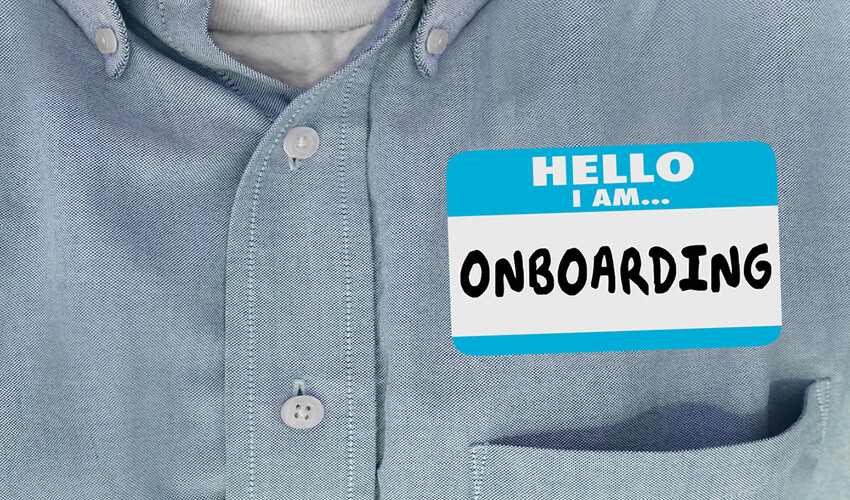Everything You Need to Know About Onboarding in 2020
Onboarding is the vital first step for your new employees. You can’t start a car without putting gas in it, and you can’t teach someone how to fish if they don’t have any bait! For this reason, onboarding should be given as much attention and care as every other aspect of Hiring Success – from creating an interview process that screens out candidates who are going to leave soon after joining up with us (or worse) steal our secrets; through effective training on procedures we want them following right away but also later down the line when management changes or company strategy shifts–and especially at making sure each employee feels like their needs are being met during those initial weeks so everyone stays tuned into what’s happening around
In an age where companies are now investing more than ever in the acquisition and retention of talent, why do anything less than guide employees from day one to their total success?
This is a question many organizations must have been asking themselves lately. With all these new resources flowing into the onboarding process, it’s time we took a closer look at what makes for memorable experiences. Your company can measure your progress by continuously building and improving on its onboarding strategy throughout every stage of this journey with our help!
What Is Onboarding?
Employee onboarding is the process of formally integrating new employees into your organization, making them feel welcome and immersed in your company’s culture. It also introduces people to their teammates, tools they will be working with as well as policies and procedures that need following. In some companies it can take a more laid back approach; others make it an intensive affair where there are presentations or meetings for passive learning on what needs doing from day one.
Onboarding is a process of getting newcomers up to speed with the company culture, goals and vision. It also provides them with all that they need for their new job: processes, tools etcetera.
Onboarding is an essential step in ensuring your employees feel comfortable and welcomed from day one on the team – especially if you want them to be productive right away!
Why It Matters
In many ways, the onboarding process isn’t so different from having to introduce yourself on your first day of school. This can be a nerve-wracking experience that unfortunately does not have an easy solution. However, there are some things you could do to make it easier for both parties and hopefully become friends quickly! All that is necessary between two strangers is a handshake and hello; this ice breaker will help facilitate relationship building between new hires with their co-workers by making them feel comfortable sooner rather than later in order they may dive right into work confidently without hesitation or regret
Most employers know that onboarding is an integral part of the employee-company relationship. But have you considered what happens when they don’t do it? Employees could feel unengaged, disengaged, and disinterested–and productivity inevitably suffers too! Fortunately there’s data to back up this theory: according to Click Boarding HR Tech based in Minnesota (you might’ve heard their slogan: “Work happy!”) those who complete a successful onboarding program are 6x less likely than others who haven’t been through one at all to leave within 12 months. So we’re not just making stuff up here folks; research backs us UP on our opinion that your company needs a formalized process for new employees coming aboard or risk losing them before
A study of a thousand different companies revealed that those with engaging onboarding programs retained 91% of their first-year workers. New hires who participate in an effective and well structured orientation program are 69% more likely to remain at the company for up to three years, which improves ROI by $79,000 annually according to this research.
The Essentials
1) Don’t Wait for Day One
Don’t wait until day one of the orientation to begin onboarding. Reach out now! These small gestures, like sending a welcome email or handwritten note to your new coworkers can make all the difference in their first few days on-board and might even encourage them to reach back through social media. It only takes minutes from you; do it today!
2) Everyone Loves a Good Story
It’s no secret that there are many reasons for why people may not want to work hard at their job. Pay is certainly a big motivator, but so too is being invested in the company they do business with on the whole. In order to get someone who doesn’t have ties yet to be committed early, it might seem like you need an ulterior motive or some type of transactional agreement – and while those things can help initially, they only go so far when you’re trying to create long-term relationships between employers and employees. There has been much change over time as well; these days what matters most isn’t just about having money in your bank account tomorrow – instead we focus more on meaningful experiences both inside our organizations
The power of words are often underestimated. This is not just for individuals, but also groups and entities (like companies). Think about it; you’re probably at least somewhat familiar with the life story of someone like Bill Gates – he founded Microsoft in a garage back in 1970’s, within 10 years became the youngest billionaire ever at 31-years old, dedicated himself to his work so much that even when diagnosed as suffering from cancer was still able to maintain an 80 hour/week schedule while speaking eloquently
Investors want to know the “who, what and why” of a company before they invest their time. When you can explain these three things about your company in an engaging way that makes people care, it will make them more excited for future success than companies without any backstory at all!
3) Provide Some Purpose
We are human because we long for a purpose in life. So, it stands to reason that people also want their careers to have some meaning behind them. This is something you should keep in mind when designing your onboarding process. What’s the overarching goal of your company? Do you have projects and goals set up which will make this idea happen? It doesn’t matter if they’re not related at all with non-profit organizations, as an accounting firm can still give employees a sense of fulfillment through different ways – such as working on tax relief programs or donating part time hours towards contributions made by other companies within the industry
Even if it’s a simple, straightforward purpose with supporting goals and objectives, you need to give your workforce an understanding of how their work fits into the larger picture. Why? People are more cooperative when they have reasons for what they do.
4) Teamwork Makes the Dream Work
The people that run your organization are the backbone of its success, which is why it’s important to emphasize values like cooperation and trust. During onboarding, make sure you set examples for these behaviors by integrating activities related to them throughout each step in orientation. It’s a continual process; impress upon new hires how integral interpersonal relationships are from day one so they will grow into healthy habits quickly before things can go awry down the line.
5) Play the Part of Cultural Informant
Make sure your new hires know the layout of the office and how people socialize. For example, if co-workers are known for their coffee breaks in the afternoon or competitive games of foosball after lunch, let them know to help them feel more confident coming into a brand new environment with little knowledge about it.
6) Formidable Forms and Formalities
A tedious task like filling out state and federal tax withholding forms is important, but can be made more interesting by informing employees of what paperwork they will have to complete before their first day.
7) Be Visual and Straightforward
New jobs can be daunting. Sometimes it can take new hires months to settle in, understand all the working parts, and realize how they fit in to the big picture. There’s a lot of information to take in at first that may seem confusing for some people who are used what their former workdays looked like before taking on this challenge.
Unfortunately (and luckily!), there has been no shortage of articles about organizational charts from companies with years worth experience creating these kinds of visuals – I’ve even seen pictures! If you want your intro meeting or orientation session go smoothly without overwhelming those newly hired employees as well as yourself by being forced into having an awkward conversation afterwards then make sure you have everything laid out neatly beforehand so everyone knows exactly where they
8) Be Resourceful and Friendly
You know how it is – new employees often come to the office and are confused about what’s going on. After all, they haven’t been here before or at least for a long time so everything looks different! As their boss you have an opportunity to help them get acclimated by letting them know where to turn if needed (and when), but also making sure that they feel comfortable with asking questions too; this way everyone will be set up for success in no time.
Make Your Checklists and Check Them Twice
An onboarding checklist can help to make sure you’re not forgetting anything when it comes to the process. And if your company’s processes are more involved, a list is essential for staying organized and on top of things like filling out forms or setting up benefits.
Or imagine the following scenario: a group of employees are onboarded and informed of a newly implemented company perk like yearly personal development budgets for everyone in the company. However, two weeks later new hires don’t receive that info during their own onboarding process to find out about it only after months or years have gone by instead.
A small oversight can happen with how many people on your team might be responsible for overseeing these types of things depending on where they fall within this responsibility matrix (can you tell I’m looking at my resume right now?) but won’t go over well if they’re under the impression there’s some kind sort-of discrimination going because other groups were given this benefit earlier than them
Keep Count of Costs to Make the Most of Your Process
Onboarding is an essential process in order to maximize the money you invest. It’s important to take into consideration associated costs, such as on onboarding paperwork and administrative time. For example, if it takes 10 hours of admin work per new hire for HR staff at $15/hour ($1050), or 8 hours of management’s time (at a salary rate) with 70 hires each year (~$8000).
The average cost to onboard a new hire is $454 per employee, but if you take into account other factors such as the time spent by IT team members and how much money goes towards hardware, software, furniture and supplies for your company’s welcome kit/package then that number can skyrocket.
Stretching Your Onboarding Bucks
When you have a more granular view of the money required for onboarding, explore products and solutions that could potentially save you valuable time. For example, if you know that administrative paperwork costs about $10500 annually on average but find out there’s an option to reduce this by half with digital document delivery from another company—that is definitely worth pursuing.
Alison JY Lee, organizational psychologist and leadership coach: “Valuable information about each new hire is collected through the hours spent in the recruiting process. By the time of onboarding, you should have a good understanding on their key strengths as well as any keys challenges that may affect them during employment at your company. If there are areas where development needs to happen right away or it will become an issue later down the line then sync with L&D so they can address these issues early.”
There’s an Integration for That
The best way to figure out how to make your applicant tracking system work for you is by picking the best product on the market. Fortunately, there are integrations that will allow you ease into onboarding with an organization and free up time from administrative tasks. Below are three examples of powerful ATS solutions:
Workday – a cloud-based human capital management software company where people can easily access information about their job as well as communicate across departments through email or chat rooms
Wrike – project manager tool which integrates with online scheduling tools such as Google Calendar and Microsoft Outlook so employees don’t have to switch between multiple systems in order finish projects effectively while staying organized (a must when juggling deadlines) The companies themselves offer
1) One Less Task to Background Check off the List
If you’ve extended a candidate an offer, chances are that they might need to run through some background checks before proceeding to the next step. Though these typically occur in food service and retail jobs more often than not, high security clearance positions also require this level of screening. Luckily for employers like yourself there is Checkr – a screen shot from their website (pictured) shows how simple it can be. Background check solutions like Checkr make it easy to quickly screen candidates with all necessary information shared with your team via the centralized location where said records will live on indefinitely afterwards so no one forgets what was found during vetting process- cutting down turnaround time while improving both quality and efficiency!
2) Signed, Sealed, Delivered!
You would think that the greatest occupational hazard for HR teams was paper cuts, but fortunately, thanks to companies like DocuSign who have made it possible to electronically create and send legally binding signatures on important documents such as offer letters and job contracts. This has saved a lot of time not only by filling out forms or going down to the post office, but also scheduling meetings exclusively for signing papers which can take up so much valuable company resources.
You wouldn’t know what one of the most difficult parts about being an HR team is from looking at them now because they don’t act too stressed anymore with their new-found technology in place—thanks mostly due to more efficient processes through digital signature software! They just go home without any worries
3) Welcome Talent as You Would Like to be Welcomed
With the help of ClickBoarding, 22% more new hires are staying with your company.
ClickBoarding is a platform that has made onboarding accessible and easy for any business looking to add some pizazz to their way of welcoming new talent by implementing branded content at every stage in the process from video greetings all the way up until employees have settled into office life.
Top 5 Takeaways to Keep in Mind
The importance of onboarding is often overlooked, but it’s worth the time and effort. Invest in a thoughtful process to make new hires feel welcome from day one—it will go a long way towards setting your company apart as an employer. Organization and standardization are key; follow formal guidelines for both materials used on-site during interview/orientation sessions with candidates, as well as digital content like preloaded email templates so you can streamline approval processes while staying true to what makes your brand unique. Finally, consider using technology where possible; tools that offer cost savings or help increase efficiency may be just right for helping you find success at every step along this critical hiring journey!
Coming Attractions—2021: SmartRecruiters’ Onboarding Solution
SmartRecruiters is pleased to announce that they will be offering onboarding functionality as a native, integrated feature on their talent acquisition software. When executed well, it helps facilitate an experience for the job seeker / soon-to-be employee that’s seamless and memorable. However, when mishandled it creates for a dissonant experience which might make new hires question whether or not they should accept the offer your company has given them – needless to say there’s a lot at stake! That being said SmartRecruiters intends to ensure all clients have access this powerful tool in order improve retention rates by streamlining processes during key transitions from “candidate” back into employment with you




